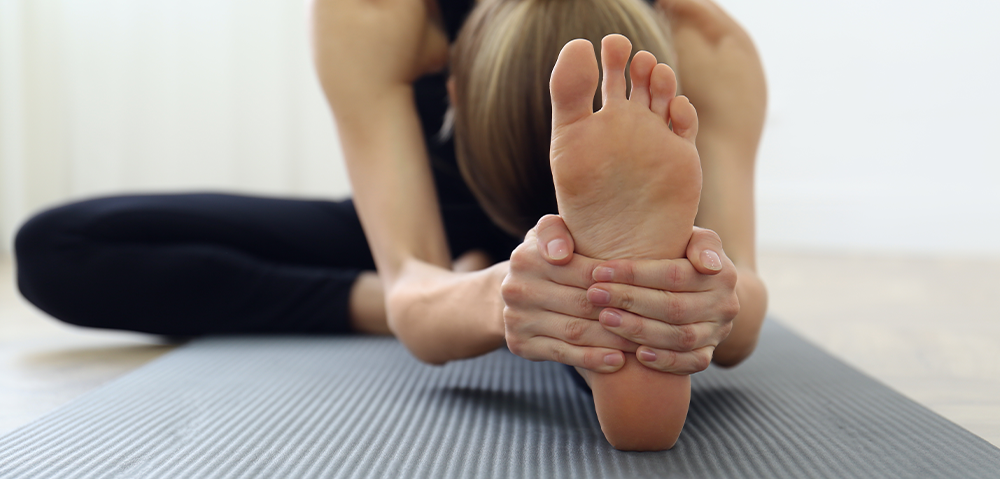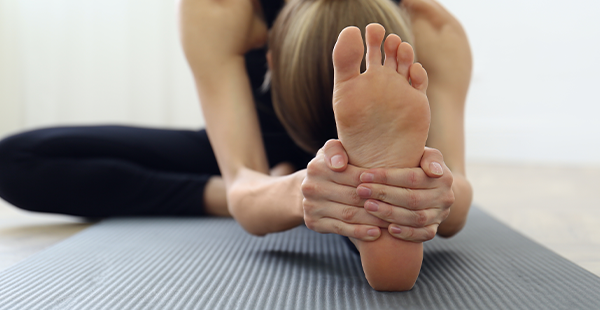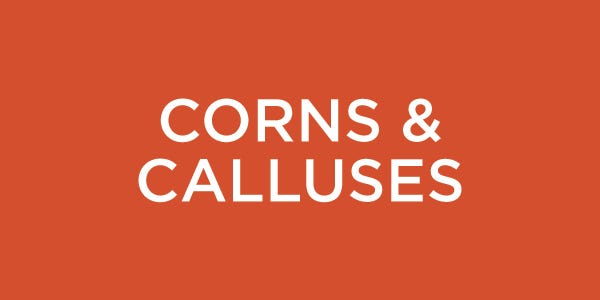

Do you experience foot pain?
Our legs and feet are a lifeline to a healthy, active lifestyle. When you’re experiencing foot issues, every step can be painful — a serious problem when work or play is impacted. Below, our Board Certified Pedorthists offer insight and shoe recommendations for 13 of the most common foot issues we see in our stores.
We have answers!
While self-diagnosis using online tools may help you to better identify your issue, it is strongly recommended that you seek an evaluation from a medical professional if pain continues or worsens. Our Board Certified Pedorthists are an extension of the medical profession and will not diagnose. Their insights and shoe recommendations are meant to supplement your doctor's treatment plan.
For best results and to ensure a proper fit for footwear and over-the-counter orthotics, it is recommended that you visit a Schuler Shoes store in person.




-
Achilles tendonitis occurs when the band of tissue that connects calf muscles to your heel bone becomes painful and inflamed. The condition commonly shows up after a sudden increase in intensity or duration of sports-related activities like running. Tenderness and heel pain are key symptoms.
Most cases can be treated under a doctor’s supervision. Serious cases of Achilles tendonitis result in tendon tears that may require surgery to repair. Self-care strategies can help prevent recurring episodes.
INSIGHT AND RECOMMENDATIONS
from Schuler Shoes' Board Certified Pedorthist
This is not a medical diagnosis but a footwear recommendation to offer symptom relief. It is meant to supplement your doctor's treatment plan.
Achilles tendonitis affects the back of the heel where the tendon attaches to the calf muscles on one end and the heel bone on the other end. In some cases, it will cause a bursa or a large bump that can be irritated by the rubbing of a heel counter. An open back clog-type shoe will offer some relief. Some examples of brands that carry styles with these features include New Balance, Haflinger, Finn Comfort, Merrell, Dansko, Birkenstock, Alegria, Vionic, Spring Footwear, and Ariat.
Insoles can also help by re-aligning the heel bone (calcaneus) in relation to the ground. A heel lift can sometimes relieve symptoms immediately, but should not be depended on for long-term relief.
Icing and very mild stretching, in accordance to a doctor’s prescribed treatment, can be very beneficial.
A consultation with a certified specialist is recommended in order to come up with and implement a plan that is best suited to the individual. -
Bunions are a bony bump that forms on the joint at the base of your toe, forcing it to angle toward the second toe. Over time, the angle of the toe joint will continue to distort. Bunions tends to run in the family and can be caused by inherited structural defects, wearing shoes that are too tight, and medical conditions such as arthritis. The condition can be very painful.
INSIGHT AND RECOMMENDATIONS
from Schuler Shoes' Board Certified Pedorthist
This is not a medical diagnosis but a footwear recommendation to offer symptom relief. It is meant to supplement your doctor's treatment plan.
A shoe with a deeper, broader toe box will help prevent rubbing and binding the toes. Some examples of brands that carry styles with these features include SAS, New Balance, Ziera, Propet, Dansko, Keen, and Haflinger.
A firmer insole with a deep heel cup will help keep the foot properly aligned. A metatarsal pad can aid in relieving symptoms, help improve the overall functioning of the foot, and slow the degenerative process. Examples include insoles from, New Balance, Superfeet, Birkenstock, Prothotic, Four Seasons or Vasyli. In addition, devices such as toe spacers, toe socks, and bunion splints can help maintain normal alignment and relieve pain.
Avoid going barefoot on hard, flat surfaces. Practice toe and foot stretching and exercises to help reduce the advancement of these conditions. A consultation with a certified specialist is recommended in order to come up with and implement a plan that is best suited to the individual. -
Corns and calluses are thick, hardened layers of skin that develop from friction and pressure. Calluses in-between or on top of the toes are often referred to as corns. If you’re healthy, you only need to treat corns and calluses if they cause discomfort.
For most people, simply eliminating the source of friction or pressure makes corns and calluses disappear. However, if you have diabetes or another condition that causes poor circulation in your feet, you're at greater risk of complications from corns and calluses. Seek your doctor's advice on proper care for corns and calluses if you have one of these conditions.
INSIGHT AND RECOMMENDATIONS
from Schuler Shoes' Board Certified Pedorthist
This is not a medical diagnosis but a footwear recommendation to offer symptom relief. It is meant ot supplement your doctor's treatment plan.
Corns can be either a soft or hard corn. Soft corns usually occur between the toes and are moist and red. They are aggravated by shoes or socks that are too tight, moisture, and toes rubbing together. Normally a wider toe box that allows for free toe movement and stockings that wick moisture away from the foot will usually offer positive results. Toe spacers and toe socks are another relief option.
Hard corns occur on the tops of toes and can happen as a result of poorly fitting shoes. A deeper toe box that does not allow the toes to rub against the top of the shoes will usually offer positive results.
Calluses most often form under the ball of the foot or on the top or the edges of the toes where they rub against the top, bottom or inner sides of the shoes. The skin thickens to protect the underlying tissue, but often adds to the problem as the callus is thick and adds more pressure to the area it is attempting to protect. Properly fitted footwear can help alleviate the pressure points causing calluses. -
Diabetic neuropathy is a type of nerve damage that can occur if you have diabetes. Diabetic neuropathy most often occurs in your legs and feet, but high blood sugar can also injure nerve fibers throughout the rest your body.
Depending on the affected nerves, symptoms of diabetic neuropathy can range from pain and numbness in your extremities to problems with your digestive system, urinary tract, blood vessels and heart. For some people, these symptoms are mild; for others, diabetic neuropathy can be painful, disabling and even fatal.
Diabetic neuropathy is a common serious complication of diabetes. Yet you can often prevent diabetic neuropathy or slow its progress with tight blood sugar control and a healthy lifestyle.
INSIGHT AND RECOMMENDATIONS
from Schuler Shoes' Board Certified Pedorthist
This is not a medical diagnosis but a footwear recommendation to offer symptom relief. It is meant to supplement your doctor's treatment plan.
Anyone with diabetes should be under the care of a physician who is monitoring the advancement of the disease. In most cases, a special custom orthotic to accommodate the foot and protect from ulceration is recommended and prescribed.
Determining the treatment protocol depends greatly on the stage or advancement. A thorough patient history and documented stage of advancement combined with a closely monitored regiment of treatment is paramount to the patient. Foot ulceration is a major concern and can lead to amputation in as little as 48 hours from onset. This type of patient will normally have a daily routine that must be implemented in addition to any footwear or insole selection.
Typically, shoes with an extra-depth toe box, removable footbed, and a seamless or nonbinding construction will offer comfort and protection for this type of foot condition. Some examples of brands that carry styles with these features include SAS, Propet and New Balance. -
Edema is swelling caused by excess fluid trapped in your body's tissues. It’s most commonly noticed in your hands, arms, feet, ankles and legs, though it can affect any part of your body. Edema can be the result of underlying medical conditions like diabetes or arthritis, certain medications, pregnancy, shoes or socks that are too tight, and shoes and socks that are too loose and unsupportive.
When valves in the blood veins don’t close all the way, the blood pools in the feet and swelling occurs. This can result in blood veins bursting, i.e. spider veins, or enlarging into varicose veins. If the issue is ignored, it can become more serious.
Symptoms develop gradually over time and include swelling or puffiness, skin that retains a dimple after being pressed for several second, rapid weight gain, and stretchy or shiny skin.
INSIGHT AND RECOMMENDATIONS
from Schuler Shoes' Board Certified Pedorthist
This is not a medical diagnosis but a footwear recommendation to offer symptom relief. It is meant to supplement your doctor's treatment plan.
A more stable and supportive shoe or insole can limit excess motion, which causes strain on the lower leg muscles. This is important because the lower leg muscles are considered to be the heart of the lower body; the action of walking and exercising causes the muscles to contract, squeezing or pumping blood up towards the heart and then on to the kidneys and liver where the blood and fluids are filtered and detoxified. Compression socks can also help as they flex and contract with walking and aid the pumping action to help circulation. -
A hammertoe and its closely related condition, mallet toe, is a toe that has an abnormal bend in the middle of the joint that causes it to curl. The condition starts out as a muscle imbalance in your foot (sometimes hereditary) that forces bones and joints to compensate.
While injury and arthritis can contribute to hammer toes, footwear that is too short or heels that are too high is thought to be the most common cause. When shoes do not fit properly, your toes may be unnaturally bent and forced against the front of your footwear, forcing your toe into hammer-like or claw-like appearance. The condition is often painful and associated with corns and calluses that result from the toe rubbing against the inside of footwear.
Relieving the pain and pressure of Hammertoe and Mallet Toe may involve changing your footwear and wearing shoe inserts. If you have a more severe case of Hammertoe or Mallet Toe, you may need surgery to experience relief.
INSIGHT AND RECOMMENDATIONS
from Schuler Shoes' Board Certified Pedorthist
This is not a medical diagnosis but a footwear recommendation to offer symptom relief. It is meant to supplement your doctor's treatment plan.
A shoe with a deeper, broader toe box will help prevent rubbing and binding the toes. Some examples of brands that carry styles with these features include SAS, New Balance, Ziera, Propet, Dansko, Keen, and Haflinger.
A firmer insole with a deep heel cup will help to keep the foot properly aligned. A metatarsal pad can aid in relieving the symptoms as well as helping to improve the function of the foot. Insoles with these features such as those by Birkenstock, Prothotic, or Vasalli can greatly improve these conditions as well as slow the degenerative process.
Avoid going barefoot on hard flat surfaces. Practice toe and foot stretching and exercises to help reduce the advancement of these conditions. A consultation with a certified specialist is recommended in order to design and implement a plan that is best suited to the individual. -
Lymphedema refers to a swelling that usually occurs in your arms or legs. The condition is caused by a blockage in the lymphatic system, part of the circulatory and immune systems. Lymph node removal or damage as a result of cancer treatment are common causes.
Symptoms of lymphedema include swelling in part of your arm or leg or your entire arm or leg, plus fingers and toes. Swelling can range from mild to extreme. Other symptoms include restricted range of motion, heaviness, aching or discomfort, recurring infections, and hardening or thickening of the skin in affected areas.
INSIGHT AND RECOMMENDATIONS
from Schuler Shoes' Board Certified Pedorthist
This is not a medical diagnosis but a footwear recommendation to offer symptom relief. It is meant to supplement your doctor's treatment plan.
Swelling is not normal and should be properly diagnosed and treated to prevent an escalation of the condition. Lymphedema is a disorder involving the lymph system. Both the lymph and venous systems are designed to clean the body of toxins and to provide fresh oxygenated blood to the body.
A stable and supportive shoe or insole can limit excess motion, which causes strain on the lower leg muscles. This is important because the lower leg muscles are considered to be the heart of the lower body; the action of walking and exercising causes the muscles to contract, squeezing or pumping blood up towards the heart and then on to the kidneys and liver where the blood and fluids are filtered and detoxified. Compression socks can also help as they flex and contract with walking and aid the pumping action to help circulation. -
Also known as a stone bruise, metatarsalgia is a type of pain and inflammation that occurs in the ball of the foot. It’s most common where the three middle toes meet the ball of the foot. Caused by increased pressure on the area, metatarsalgia can be brought on by being overweight, wearing shoes that don’t provide enough support or cushioning, or having bunions or hammer toes.
Symptoms can include sharp pain in the toes, increased pain when walking barefoot, and a feeling in your feet as if you’re walking with a pebble in your shoe.
INSIGHT AND RECOMMENDATIONS
from Schuler Shoes' Board Certified Pedorthist
This is not a medical diagnosis but a footwear recommendation to offer symptom relief. It is meant to supplement your doctor's treatment plan.
Also referred to as forefoot pain, this ball of foot condition will require an insole that will do one of two things:- Off load the metatarsal heads and re-establish a normal transverse arch
- Provide a softer interface between the sore metatarsals and the ground
Typically a rocker motion shoe will bring relief as it decreases the amount of time one spends on the ball of the foot. Also a wider, moccasin style toe box or an oblique toe box will aid tremendously as this type of pain can be caused by lateral forces squeezing the toes together.
Dress shoes, high heels, pointed toes, and soft, extremely flexible shoes will only intensify the pain and should be avoided. Also, going barefoot on a hard flat surface will aggravate the condition.
These conditions can be difficult to properly identify and one should typically have a proper diagnosis prior to treatment. In most cases a better shoe and insole will not cause further damage and can certainly slow the degenerative process. -
Weakness, numbness, and pain from nerve damage that usually occurs in the hands and feet. Causes include diabetes, injuries, infections, vitamin deficiency, kidney failure, shingles, chemo therapy, and certain kinds of drugs.
Symptoms can include numbness, burning, weakness, pain, poor balance, tingling, or a pins-and-needles sensation.
INSIGHT AND RECOMMENDATIONS
from Schuler Shoes' Board Certified Pedorthist
This is not a medical diagnosis but a footwear recommendation to offer symptom relief. It is meant to supplement your doctor's treatment plan.
There are differing levels and types of neuropathy and some can be either hypersensitive or completely insensate (lacking physical sensation). Depending on the type of neuropathy and the stage, it is critical to have a doctor determine a treatment protocol. A thorough patient history and documented stage of advancement, combined with a closely monitored regiment of treatment is paramount to the patient. Foot ulceration is a major concern, as it can lead to amputation in as little as 48 hours from onset, if diabetic.
This type of patient will normally have a daily routine that must be implemented in addition to any footwear or insole selection. Typically, shoes with an extra-depth toe box, removable footbed, and a seamless or nonbinding construction will offer comfort and protection for this type of foot condition. Some examples of brands that carry styles with these features include SAS and New Balance.
Anyone with diabetes should be under the care of a physician who is monitoring the advancement of the disease. In most cases, a special custom orthotic to accommodate the foot and protect from ulceration is recommended and prescribed. -
Plantar Fasciitis is one of the most common causes of heel pain. It involves pain and inflammation of a thick band of tissue, called the plantar fascia, which runs across the bottom of your foot — connecting your heel bone to your toes.
Plantar fasciitis causes stabbing pain that usually occurs with your very first steps in the morning. Once your foot limbers up, the pain of plantar fasciitis normally decreases, but it may return after long periods of standing or after getting up from a seated position. Plantar fasciitis is particularly common in runners. People who are overweight, women who are pregnant and those who wear shoes with inadequate support are at a higher risk of plantar fasciitis.
INSIGHT AND RECOMMENDATIONS
from Schuler Shoes' Board Certified Pedorthist
This is not a medical diagnosis but a footwear recommendation to offer symptom relief. It is meant to supplement your doctor's treatment plan.
Plantar Faciitis typically responds well to a good supportive insole, with certain insoles working better with certain types of foot structures. As a starting point, a Four Seasons insert will normally offer a noticeable degree of relief. However, there are several over-the-counter brands available and each has its own merit based on the type of foot, planned activity, and type of shoe the person requires.
Generally, a stiffer sole with rocker motion will offer the greatest relief. Examples of brands that carry shoes with these features include New Balance, Finn Comfort, Wolky, and Alegria. The Haflinger clog or house shoe has also proved to be a great tool to aid healing.
This condition normally will require a significant amount of additional stretching and range of motion exercises in order to obtain lasting results, thus one cannot rely on the shoe or insert alone. If this is a long-term issue or is chronic and not responding to stretching, this may not be an isolated foot issue and it is recommended to have the problem evaluated by a medical professional. -
As you heal from foot surgery and slowly transition from recovery boot or half shoe into regular footwear, finding appropriate footwear for your feet is essential. Discuss the following items with your footwear consultant or Board Certified Pedorthist.
- Make sure to have both feet measured when you start looking for shoes, as your feet very likely changed in some way.
- Location(s) you are experiencing pain, discomfort or swelling
- Placement of pins or bone fusions, if any. A stiff rocker bottom shoe might be appropriate in these cases.
- Be open to footwear styles you may have never considered or pictured as a high level of comfort is key to complete healing.
INSIGHT AND RECOMMENDATIONS
from Schuler Shoes' Board Certified Pedorthist
This is not a medical diagnosis but a footwear recommendation to offer symptom relief. It is meant to supplement your doctor's treatment plan.
Shoes with few internal seams will keep friction between your feet and the shoe to a minimum. Deeper and wider-fitting shoes will allow for swelling and bandages and shoes with mesh are very forgiving around tender spots. Examples of brands that carry shoes with these features include New Balance and SAS. -
The tendon that holds up the arch and supports the foot when walking becomes inflamed or torn. The result is loss of stability and support of the foot’s arch that can result in flattening of the foot. Injuries, overuse, diabetes, hypertension, and being overweight are all possible causes.
Symptoms include pain on the inside of the foot and ankle or pain on the outside of the ankle. Pain often worsens with activity.
INSIGHT AND RECOMMENDATIONS
from Schuler Shoes' Board Certified Pedorthist
This is not a medical diagnosis but a footwear recommendation to offer symptom relief. It is meant to supplement your doctor's treatment plan.
Sometimes referred to as a relaxed or acquired flatfoot, dysfunction in this tendon can lead to structural changes in the foot such as a lowering of the arch. As the condition progresses and the arch flattens, bones in the foot may become displaced and an internal rotation of the bones in the leg can lead to stress on the ankle and knee joints.
Conservative treatment with a wide-based rocker toe shoe and functional arch support is recommended. An insole or orthotic to reduce symptoms and help maintain structural integrity may be used in early intervention. -
Varicose veins are gnarled, enlarged veins. Any vein may become varicose, but the veins most commonly affected are those in your legs and feet since standing and walking upright increases the pressure in the veins of your lower body. Varicose veins are simply a cosmetic concern for most people. For others, varicose veins can cause aching pain and discomfort. Sometimes varicose veins lead to more-serious problems and may also signal a higher risk of other circulatory problems.
Rapid weight gain will usually preclude this condition and it may come and go depending on diet, amount of exercise, or in the case of pregnancy in women. Symptoms can include veins that appear a blue or dark purple color, or twisted and bulging. An achy or heavy feeling in your legs, itching around one or more of your veins, and worsened pain after sitting or standing for a long period of time are also associated.
INSIGHT AND RECOMMENDATIONS
from Schuler Shoes' Board Certified Pedorthist
This is not a medical diagnosis but a footwear recommendation to offer symptom relief. It is meant to supplement your doctor's treatment plan.
A more stable and supportive shoe or insole can limit excess motion, which cause strain on the lower leg muscles. Additionally, the lower leg muscles are considered to be the heart of the lower body and the action of walking and exercising causes the muscles to contract. This action squeezes or pumps the blood up towards the heart and then on to the kidneys and liver, where the blood and fluids are filtered and detoxified. Compression socks such as those by Sockwell and Goodhew can also help as they flex and contract with walking and aid the pumping action.








 Achilles Tendonitis
Achilles Tendonitis